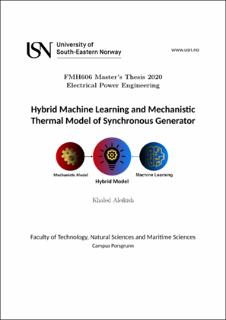| dc.description.abstract | Strict constraints are imposed on the power factor in the operation of the synchronous machines for electricity production, which are in place to protect the synchronous generators from overheating due to the increase in currents from a high power factor. However, by exploiting the total thermal capacity of the synchronous generator and by keeping temperature development in key points under control, it is possible to relax the constraints on the power factor. A thermal model of an air-cooled synchronous generator was proposed in Øyvang (2018) and studied in Lie (2018a). A possible extension of this model is the case of temperature dependence in the heat capacities of air and water in the counter-current heat exchanger. To handle this case, it is necessary to solve a nonlinear two-point boundary value problem numerically for each time step when solving the thermal synchronous generator model, which is relatively costly for online use. In this thesis work, to speed up the solution time of the non-ideal heat exchanger sub-model, explicit data-driven models were developed using linear and nonlinear regression for a variety of conditions and expressed as a correction expression to the ideal heat exchanger model. Moreover, the execution speed of the numeric solution of the nonlinear two-point boundary value problem was compared with that of the explicit data-driven models. Also, the experimental data of Åbjøra was compared with the predictions of the mechanistic model, and it was observed that even when extending the model from Lie (2018) with a more realistic heat exchanger model with temperature dependence in the specific heat capacities of air and water, it was not possible to get a good fit to the available experimental data. To get improved model fit, one possibility is to model the system as good as possible with a mechanistic model and then add a dynamic regression model to describe the difference between the mechanistic model and the experimental data. In summary: a hybrid mechanistic-empirical model is a hot research topic. The promise is to get a good model fit, with efficient model simulation. | en_US |
